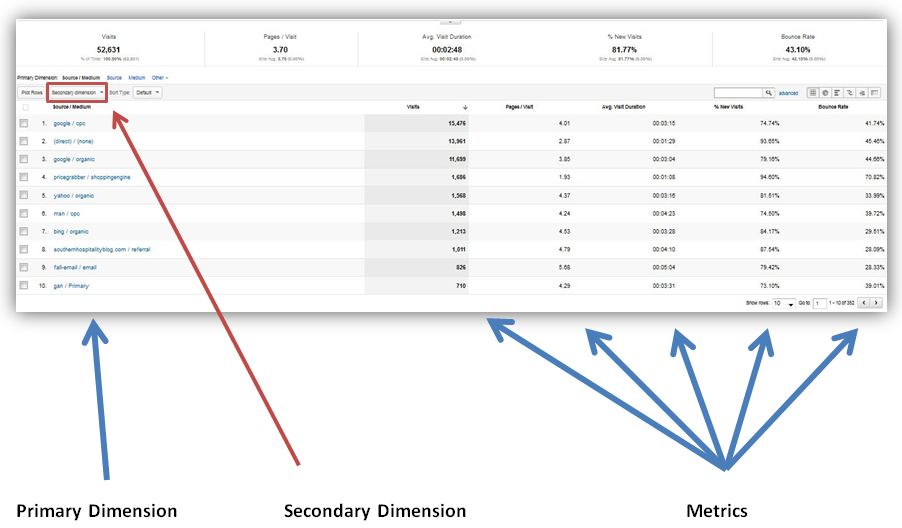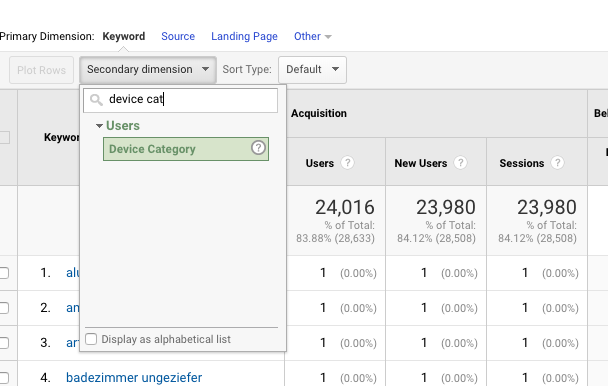Transform Your Analytics Method With Second Measurement in Google Analytics
By incorporating additional dimensions right into information evaluation, a brand-new layer of insights arises, dropping light on detailed customer habits and communications. The critical application of secondary measurements holds the key to unlocking a treasure chest of very useful info that can change exactly how businesses translate and act upon their data.
Comprehending Additional Measurements in Google Analytics
Secondary measurements in Google Analytics provide extra context to key data by enabling customers to analyze metrics throughout a 2nd measurement, offering deeper understandings right into user habits and communications on a website. Secondary Dimension in Google Analytics. While main measurements provide essential information factors such as pageviews, bounce price, and session duration, secondary dimensions provide a more thorough view by segmenting the primary data additionally. This division enables customers to evaluate metrics in combination with one more measurement, such as website traffic resources, demographics, or customer behavior
Benefits of Using Second Dimensions
Utilizing secondary dimensions in Google Analytics provides a critical benefit by boosting the deepness of evaluation and offering a much more detailed understanding of individual communications and habits on a web site. By including second measurements, analysts can get useful understandings right into the efficiency of certain sections or variables within their information. This allows a much more thorough evaluation of user behavior past surface-level metrics, permitting a much deeper expedition of the aspects influencing user involvement and conversions.

How to Apply Additional Measurements
When integrating second measurements in Google Analytics, one necessary step is to choose the appropriate metrics and measurements to enhance the evaluation process. Clicking on this switch will certainly open a drop-down food selection listing numerous dimensions that can be added to your main dimension for deeper understandings.
After selecting the suitable additional dimension, such as 'Source/Medium' or 'Tool Group,' Google Analytics will show the data in a more thorough style, allowing you to cross-analyze different facets of individual actions. Keep in mind to explore various combinations of second and key measurements to discover useful patterns and patterns that can notify your advertising and marketing strategies. By implementing secondary dimensions attentively, you can obtain a more extensive pop over to this web-site understanding of your website or app performance and make data-driven decisions to maximize your electronic visibility.
Studying Data With Secondary Measurements
Improve your data evaluation in Google Analytics by including additional dimensions to dive deeper into customer habits patterns and optimize your electronic advertising techniques efficiently - Secondary Dimension in Google Analytics. By including additional measurements to your main data, you can obtain important understandings that can help you make educated decisions concerning your site or application performance
Analyzing information with secondary measurements allows you to segment your key data better, supplying a more detailed view of individual communications. For circumstances, combining the main measurement of 'source/medium' with an additional dimension like 'touchdown web page' can reveal which details pages are driving website traffic from different resources. This information can be crucial in refining your material approach or optimizing your ad campaign to boost conversions.
Furthermore, using second measurements enables you to determine correlations in between different metrics, assisting Continue you recognize the impact of different variables on user actions. Whether it's examining demographics alongside user interaction metrics or gadget classifications with conversion prices, second measurements empower you to uncover hidden trends and patterns that can direct your advertising and marketing initiatives.
Maximizing Efficiency With Second Measurements
To boost the performance of information evaluation and decision-making in Google Analytics, including second measurements is crucial to maximizing efficiency metrics and gaining deeper understandings right into customer habits patterns. By using additional dimensions, analysts can dig past surface-level information and discover useful connections that may otherwise go unnoticed. This optimization approach makes it possible for businesses to customize their advertising and marketing efforts better, recognize locations for improvement in internet site usability, and boost general user experience.
Secondary measurements use a more comprehensive sight of individual interactions by providing added context to main data metrics. Coupling the main measurement of 'touchdown page' with a second dimension like 'tool classification' can reveal whether particular gadgets are more most likely to drive interaction on specific landing pages. This understanding can inform receptive style enhancements or targeted advertising and marketing techniques to boost efficiency.

Final Thought
To conclude, the integration of secondary measurements in Google Analytics gives businesses with a powerful device to boost their analytics method. Secondary Dimension in Google Analytics. By diving deeper right into user behavior and interactions, online marketers can uncover important insights that can drive performance optimization and boost the general user experience. Leveraging additional measurements enables a more detailed analysis of data, bring about more enlightened decision-making and tailored marketing efforts
Second dimensions in Google Analytics give additional context to key data by enabling customers to examine metrics throughout a second measurement, supplying deeper insights into customer useful content behavior and communications on a website. While main measurements offer basic data factors such as pageviews, bounce rate, and session duration, second dimensions use an even more in-depth sight by segmenting the key data even more.One of the vital advantages of making use of secondary dimensions is the capability to uncover connections and patterns that might not be promptly apparent when examining information with main measurements alone.When including second measurements in Google Analytics, one important step is to choose the relevant metrics and dimensions to enhance the analysis process. Matching the main measurement of 'touchdown web page' with an additional measurement like 'gadget classification' can expose whether specific gadgets are more likely to drive interaction on certain landing pages.